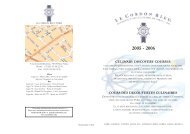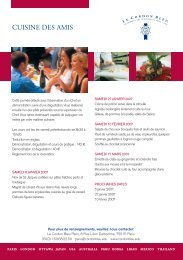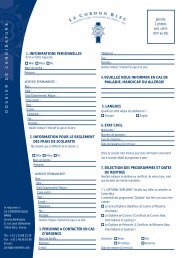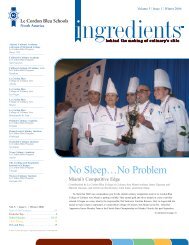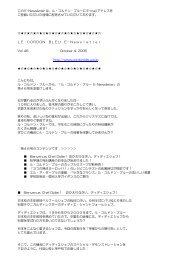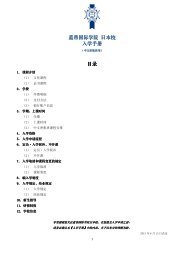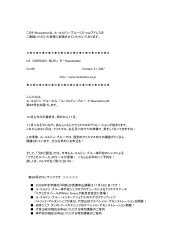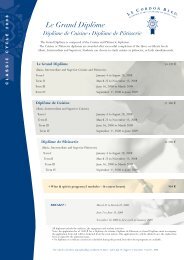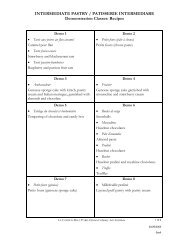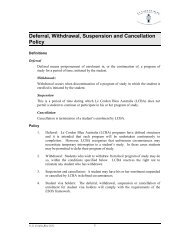Prospectus 2009 - Le Cordon Bleu
Prospectus 2009 - Le Cordon Bleu
Prospectus 2009 - Le Cordon Bleu
You also want an ePaper? Increase the reach of your titles
YUMPU automatically turns print PDFs into web optimized ePapers that Google loves.
<strong>Le</strong> <strong>Cordon</strong> <strong>Bleu</strong>Master of Arts in GastronomyCRICOS Course Code: 039353J• Principles of Gastronomy• Food and Drink in Contemporary Western Society• Gastronomy and Communication• Gastronomic Tourism or Food & Wine Technology• Research Dissertation (15000–18000 words) orTwo Research Projects (8000–9000 words each)Nested AwardsWhile the program leads ultimately to the degree ofMaster of Arts in Gastronomy, qualifications rangingfrom Professional Certificate of Gastronomy to GraduateDiploma of Gastronomy are awarded at various stagesof completion.Entry to the Graduate Certificate of Gastronomy throughto the Master of Arts in Gastronomy is conditional uponsuccessful completion and attaining a “credit gradeaverage” or higher in coursework.<strong>Le</strong> <strong>Cordon</strong> <strong>Bleu</strong> Professional Certificate of GastronomyCRICOS Course Code: 039350A• Principles of Gastronomy<strong>Le</strong> <strong>Cordon</strong> <strong>Bleu</strong> Graduate Certificate in GastronomyCRICOS Course Code: 054508C• Principles of Gastronomy• Food and Drink in Contemporary Western Society<strong>Le</strong> <strong>Cordon</strong> <strong>Bleu</strong> Graduate Diploma in GastronomyCRICOS Course Code: 054509B• Principles of Gastronomy• Food & Drink in Contemporary Western Society• Gastronomy and Communication• Gastronomic Tourism or Food & Wine TechnologyCore CoursesPrinciples of GastronomyThe first of the three core courses, Principles of Gastronomyaims to give students an introduction to some of the basic conceptsof gastronomy. It examines the cultural meanings of food andhow these influence what we eat (and what we don’t eat),changes in meals, mealtimes and drinking habits from ancienttimes to the eighteenth century, the evolution of cuisines and theinfluence of cookbooks as agents of culinary transmission, andthe development of traditions of hospitality.Food and Drink in Contemporary Western SocietyFood and Drink in Contemporary Western Society is designed toencourage students to apply basic gastronomic principles learntin the previous course in a contemporary context. How andwhy have the values we attribute to particular foods changed?What was the background to the Nouvelle Cuisine revolution,and what is its legacy? Do we now drink better, but less? Is thereany link between the surge in popularity of organic foods andvegetarianism? Are regional foods necessarily authentic?Such questions form the basis of discussion and debate in Foodand Drink in Contemporary Western Society. Focusing on thetwentieth century, it presents a detailed analysis of developmentsin food and drink, production and processing technologies,cuisine and taste, eating habits and restaurants, gastronomicpublishing and gastronomic tourism.Gastronomy and CommunicationThe last of the three core courses, Gastronomy and Communicationexamines food (and drink) as a medium of communicationas well as communication about food and drink. It aims toencourage students to express ideas, opinions and evaluationsrelating to food and drink, with particular emphasis on writing.Beginning with an introduction to the concept of food and drinkas a means of communication, particularly in relation to ritualsand festivities, the course explores the role and use of foodand drink in literature and films – how it contributes to plot orcharacterisation or generally enhances the work. It also examinesfood in art and the arts of the table.In addition students examine selected examples of food and winewriting and learn something of the craft of writing as well as editingskills and recipe writing techniques. They study the responsibilitiesand duties of a food or restaurant critic and write a series ofrestaurant reviews as part of their assessment for the course.They discuss the art of menu writing and menu design, assess andanalyse television cooking programs in order to identify successfuland unsuccessful formulae for different viewing audiences.Food & Wine TechnologyThis course is designed to develop an understanding andappreciation of food production and wine making practices andhow these affect the enjoyment of food & wine by the consumer.It examines food processing techniques and their influence on thequalities and sensory characteristics of the final food product, foodhygiene and safety requirements and links between the foodindustry and health. The wine component of the course reviewsthe production and characteristics of major wine styles, relatingthem to regions and grape varieties of the world. It also coverscorrect handling practices and an understanding of charactersused for wine evaluation.Gastronomic TourismGastronomic Tourism explores the food and drink experiencesof tourists and examines various kinds of gastronomicattractions at a destination. It shows how food and drink ata destination enable tourist to participate in the local culture.It includes discussion of markets, food festivals and food/winetrails. It also considers the factors that influence tourists toseek food and drink experiences at a destination and it examinesstrategies for developing gastronomic attractions to satisfytourist demand. It discusses the way in which food and drinkare used to promote the image of a destination and assessesthe role of gastronomic tourism in diversifying and strengtheningrural economies.Research Projects and DissertationStudents have a choice of writing either two research projectsof 8,000–9,000 words each or a dissertation of 15,000–18,000words to complete their Master of Arts.<strong>2009</strong> <strong>Prospectus</strong> <strong>Le</strong> <strong>Cordon</strong> <strong>Bleu</strong> Australia Pty Ltd • CRICOS Provider SA: 01818E NSW: 02380M 11




